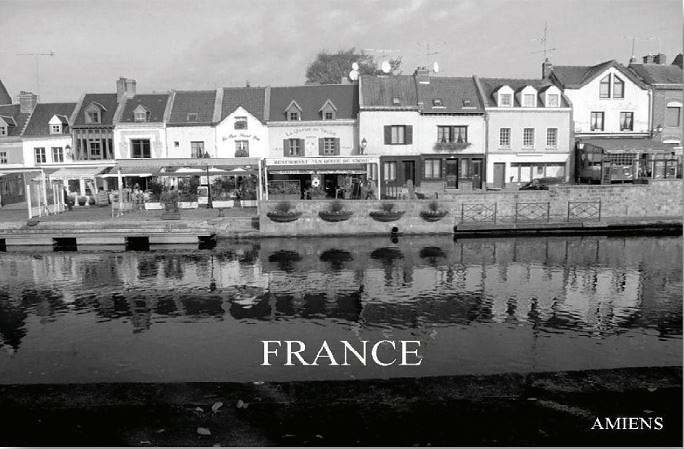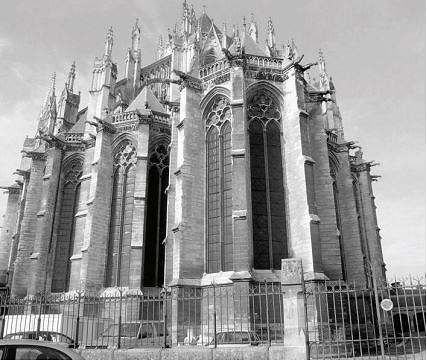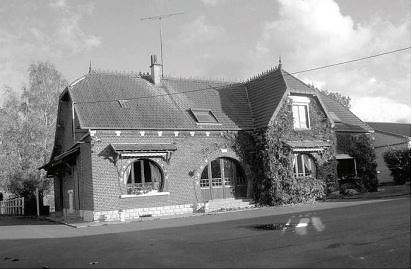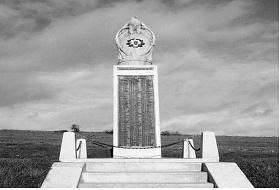
THE SOMME REGION
October 2009
In late October I traveled to the region of the Somme Valley in France while visiting my son and his family, who live in Brussels. The major city in the area is Amiens, which is two hours south of Brussels and one hour north of Paris. We spent about a week in this fascinating northern corner of France, thanks to my grandchildren’s All Saints Day vacation. Our base in Omniécourt, a rural community near Amiens, was the country house of an 18th-century château, restored to provide furnished lodging for visitors. Found on the Internet, our three-bedroom cottage came with a fully equipped kitchen and an indoor swimming pool, which my grandchildren enjoyed daily, as it was too chilly to use the outdoor pool.
Our excursions began in the historical Saint-Leu district of Amiens with its many connecting canals. This part of the city, the oldest, used to be the prosperous weavers’ and dyers’ quarter. Now small houses with colorful facades, as well as cafes, restaurants, and pubs with outdoor terraces line the picturesque canals. People stroll by craft shops, antique stores, and second-hand dealers, contributing to the vitality of the area, which overflows with people during the Saturday morning farmer’s market. Once a year in June, the market is held as in the old days, from boats and in period dress.
The Saturday market was winding down when we arrived; yet the aroma of fresh-baked bread made from locally grown wheat still hung in the air. Large radishes, cauliflower, and ground artichokes stood out in the stalls. I sampled the macaroons, made with almonds and honey, but not the other local specialty, goose liver pâté with pistachios. The macaroons were delicious.

Cathedral of Notre Dame
The Cathedral of Notre Dame in the same historic district is the largest Gothic edifice in France. Begun in 1220, this majestic structure with its lacy stonework is 145 meters long and 70 meters wide — twice the size of Notre Dame de Paris. The nave of the cathedral is the tallest in the world, and its spires the oldest. This wooden structure, covered with lead sheeting, rises to a height of 112 meters. The main facade has three deep-set portals, featuring groups of carved statues and surrounded by four rows of leaves. One is struck by a sense of immensity upon entering the cathedral, with its especially impressive statues. The choir stalls have 4000 sculpted figurines illustrating former trades or representing religious scenes. Noted for the harmony and purity of its proportions, the cathedral was designated a World Heritage Site by UNESCO in 1981 as an outstanding architectural work, and again in 1998 as a stage on the pilgrimage to Santiago de Compostela in Spain. Amiens prides itself on having the Head of Saint John the Baptist in its cathedral. The head, set on a silver tray, is brought out for the congregation to revere every year on June 24.
Jules Verne’s house is another must-see site in Amiens. Verne married a woman from Amiens and lived here from 1871, when he was 43 years old, until his death in 1905. Most of the works that made him famous were written in this house. Renovated in 2005, the house is full of mementos of the author’s life and work. A tour of the 19th-century townhouse begins in the winter garden on the ground floor and ends in the rooms of the attic, which have been transformed to look like the cabins of a ship, leading the visitor to relive the adventures of the writer’s heroes. Taking an active part in the city’s public life, Verne inaugurated a circus in 1889; the circus, named after its founder, continues to this day.

Farmhouse with decorative facade
Houses, museums, churches, gardens, and parks in this part of France are marked by the exuberant charm of the Belle Epoque. Wrought iron balconies, bow windows, colored facades, and an explosion of ornamentation delight the eye. Decorative brickwork on the facades and roofs of farmhouses show individual flair.
45 minutes from Amiens is Somme Bay. In keeping with the character of the period, a local train pulled by a steam locomotive travels between towns around the Bay. We rode the train on its last day of service for the season. The trains run between April 1 and October 31, as it is not equipped to deal with winter weather. One of the windows of our train kept sliding down as we rode, letting in torrential rain.
Somme Bay has vast skies and expanses of open water, marshes, dunes, and saltwater meadows, which create a landscape of monochromes in gray, beige, or white. Harbor seals mix with birds. The Bay is the largest estuary in northern France. At the heart of the Bay’s nature reserve is the Marquenterre Bird Sanctuary, a favorite stopping place for thousands of migratory birds. Bracing sea air and rain kept us from viewing a colony of seals.
The local guide we had contacted recommended that we instead visit the Maison de l’Oiseau, an ornithological center for learning about, seeing, and hearing flora and fauna from the Bay. We viewed stuffed animals in simulated action in their natural habitat in large, beautifully laid out glass cases. To this observer they were absolutely lifelike; a bird in simulated flight looked no different from one in the open sky.
The Somme region consists of Somme Bay, the city of Amiens, and the Somme Valley. The area was deeply scarred by World War I, making it famous for its battlefields as much as for its natural beauty. The 1916 Battle of the Somme was fought on a vast scale in terms of the numbers of countries involved and of the dead, missing-in-action, and wounded on both sides, as well as of scars left in the ground — trenches, mine craters, vegetation destroyed, and villages reduced to rubble. The Remembrance Circuit is an itinerary linking two cities which symbolize the First World War, Albert and Peronne, northeast and east of Amiens respectively.
A map of this circuit identifies a dozen sites essential to understanding the history of World War I. Among them are Peronne’s Great War Museum, depicting the everyday life of French and British soldiers and civilians during the conflict; the 1916 Museum in Albert, retracing life in the trenches during the July 1 offensive; the South African Museum and National Memorial in Longueval, paying homage to South African soldiers; the Franco-British Memorial in Thiepval, bearing the names of 73,367 soldiers who died at the front and who lie in unmarked graves; the Newfoundland Memorial in Beaumont-Hamel, featuring a network of well preserved trenches; the Lochnager crater in Boisselle, showing the immense remains of a series of explosions that occurred on July 1, 1916; and the Australian National Memorial in Villers-Bretonneux, paying homage to the soldiers who died during the Great War.
The underground city of Naours is a network of 300 chambers hollowed out of limestone in the Picardy Plateau. The cave chambers sheltered local people and their livestock during the numerous invasions which took place from the 11th to the 20th century. This complex, which sheltered up to 2600 people at any given time, was well organized and included public meeting places, stables, wells, chimneys, and a chapel with three naves. It was used by the British during World War I, and was a command post for the German army in World War II.

Memorial to
American soldiers
A 30-minute drive east of Amiens in the Somme Valley leads to a memorial paying homage to American soldiers who died in World War II. Guarded by a stone eagle at the top, the monument, bearing names inscribed on a metal plaque, sits by the roadside, surrounded by fields steeped in the memory of the War. A battleground during both World Wars, these fields offer peace and tranquility at last.
Having two children with us, ages three and five, encouraged us to explore the wealth and diversity of the Somme region beyond its landmarks and heritage sites. We visited apple orchards, fed horses, and visited a small aquarium run by a passionate volunteer. The best excursion was to a farm where natural blue dyes are made from the leaves of a plant which thrives in chalky soil. Here the children observed all the stages in the process of making and using the dyes. The Somme region was the traditional center of blue dye production for all of France from the Middle Ages on, and the river was used to transport this main source of wealth throughout the country.
The Somme region, from its bay to its cities and valley, offers much to discover for the visitor. It is an area I would like to return to another time.
